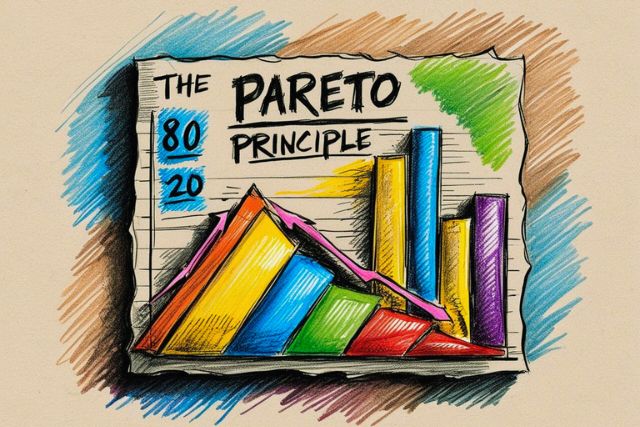The Pareto Principle: Discover How to Achieve More with Less
The Pareto Principle, also known as the 80/20 rule, is a powerful concept that helps busy professionals maximize efficiency. First introduced by Italian economist Vilfredo Pareto, this principle emerged when he observed that 80% of Italy’s land was owned by 20% of the population. Over time, this idea has evolved into a broader realization—a small number of causes often lead to the majority of effects across different areas.
The Pareto Principle is widely applied in economics, business, and productivity. In economics, wealth distribution often follows the 80/20 pattern, where a small percentage of people control most resources. In business, companies frequently find that 80% of sales come from just 20% of their clients, and similarly, 80% of customer complaints stem from 20% of users. When it comes to productivity, professionals notice that a small fraction of tasks generate the majority of results, making it essential to prioritize high-impact activities.
For busy professionals, the Pareto Principle is a game-changer. By identifying the most valuable 20% of tasks that yield the highest returns, they can achieve more with less effort. This mindset allows for smarter work prioritization, eliminating low-value tasks and reducing stress while improving productivity.
To explore the origins and deeper applications of the Pareto Principle, authoritative resources like Wikipedia and Investopedia provide valuable insights. Mastering this principle can help professionals optimize their time and work smarter, not harder.
Applying the Pareto Principle in Professional Life
The Pareto Principle, or the 80/20 rule, asserts that 80% of results come from 20% of efforts. Applying this principle in professional life can significantly enhance productivity and efficiency. The first step is identifying the critical 20% of tasks that yield the most substantial outcomes. This can be achieved through a thorough analysis of your daily activities, projects, and goals.
To start, list all your tasks and categorize them based on their impact. Often, the tasks that contribute most to your success are those that align with your core objectives and long-term goals. Once identified, these high-impact activities should be prioritized. For example, in project management, focus on key milestones and deliverables that drive the project forward. In sales, prioritizing high-value clients and leads can yield disproportionate results. In marketing, concentrating on campaigns with the highest engagement rates can maximize returns.
Allocating resources effectively is crucial. Delegate or outsource low-impact tasks to free up more time for critical activities. Implementing time management frameworks such as the Eisenhower Matrix can help in distinguishing between urgent and important tasks, ensuring that your focus remains on high-impact activities. Additionally, employing productivity tools like Trello, Asana, or Monday.com can streamline task management and collaboration, enabling you to keep track of priorities and progress.
Real-life examples from various industries illustrate the effectiveness of the Pareto Principle. In healthcare, medical professionals have found that focusing on critical cases and high-risk patients can improve overall health outcomes. In the tech industry, software development teams often identify key features or bugs that, when addressed, substantially enhance user experience and satisfaction.
For further insights and tools to aid in the application of the Pareto Principle, explore productivity tools reviews and case studies. These resources can offer practical guidance and real-world examples, helping you to streamline your workload and achieve more with less effort.
Overcoming Challenges in Implementing the Pareto Principle
Applying the Pareto Principle in a professional setting is not without its challenges. One common obstacle is misidentifying the key tasks that yield the highest impact. It is crucial to accurately pinpoint the 20% of activities that will drive 80% of results. This requires a detailed analysis of tasks and their outcomes, which can be time-consuming but ultimately rewarding.
Resistance to change is another significant hurdle. Colleagues and team members may be hesitant to adopt new methodologies, especially if they are accustomed to a different workflow. This resistance can be mitigated by clearly communicating the benefits of the Pareto Principle and involving team members in the identification and prioritization process. Additionally, demonstrating small, quick wins can help build momentum and buy-in.
Quantifying the impact of certain activities can also be challenging. Not all tasks have easily measurable outcomes, which can make it difficult to determine their true value. In such cases, qualitative assessments and regular reviews can be beneficial. Conducting periodic evaluations allows for adjustments and helps refine the focus on activities that genuinely contribute to the desired outcomes.
Flexibility is essential when implementing the Pareto Principle. The dynamic nature of professional environments means that priorities can shift rapidly. Maintaining an adaptable approach ensures that the principle remains effective even as circumstances change. Regular feedback from colleagues and stakeholders can provide valuable insights and help fine-tune the process.
Success stories from professionals who have integrated the Pareto Principle into their routines serve as practical examples of its efficacy. For instance, a marketing manager reported a 60% increase in campaign effectiveness by identifying and focusing on the top-performing strategies. Similarly, a project manager successfully reduced project timelines by 40% through meticulous task prioritization.
For further reading on overcoming resistance to change, Harvard Business Review offers valuable insights. Additionally, Mind Tools provides case studies of successful implementation, which can serve as a guide and inspiration for professionals seeking to leverage the Pareto Principle.
Long-term Benefits of the Pareto Principle for Professionals
Consistently applying the Pareto Principle, also known as the 80/20 rule, can yield substantial long-term benefits for professionals aiming to enhance their productivity and overall career trajectory. By focusing on the 20% of tasks that generate 80% of the results, professionals can streamline their efforts, leading to improved productivity. This strategic approach allows individuals to allocate their time and resources more effectively, ensuring that high-impact activities receive the attention they deserve.
One significant advantage of this principle is the potential for a better work-life balance. By prioritizing critical tasks, professionals can avoid the common pitfall of overextending themselves, thus reducing stress and preventing burnout. This balance is crucial for maintaining long-term career satisfaction and personal well-being. Studies, such as those published in the National Center for Biotechnology Information, emphasize the correlation between effective time management and reduced stress levels, further underlining the importance of the Pareto Principle.
Moreover, the Pareto Principle fosters a mindset of continuous improvement and strategic thinking. Regularly reassessing priorities ensures that professionals remain adaptable and responsive to changing circumstances. Setting long-term goals and breaking them down into manageable tasks can help maintain focus and motivation. Incorporating new productivity techniques, such as those discussed in Harvard Business Review, can further enhance this practice, enabling professionals to stay ahead in their fields.
To sustain the benefits of the Pareto Principle, it is essential to periodically evaluate one’s workload and adjust priorities accordingly. This practice ensures that efforts are consistently aligned with the most impactful activities. By staying informed about new productivity strategies and integrating them into daily routines, professionals can continue to optimize their performance and achieve their long-term career goals.
Final Thoughts: Harness the Power of the Pareto Principle
The Pareto Principle is more than just a productivity hack—it’s a mindset shift that can help you work smarter, not harder. By focusing on the vital 20% that drives 80% of your results, you can eliminate distractions, streamline your workflow, and make a greater impact with less effort.
Success isn’t about doing more; it’s about doing what truly matters. Start applying the Pareto Principle in your daily routine, whether it’s prioritizing key projects, managing your time effectively, or optimizing your personal growth.
Take action today! Identify your most valuable tasks, cut out the noise, and let the Pareto Principle guide you toward greater productivity and success.
















